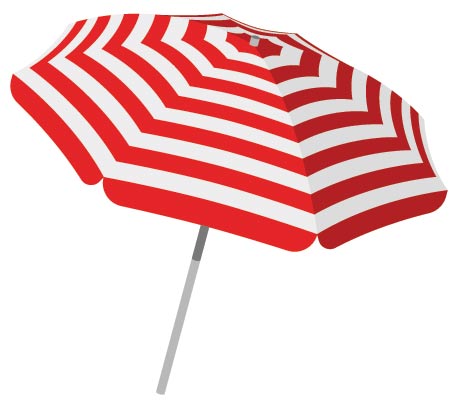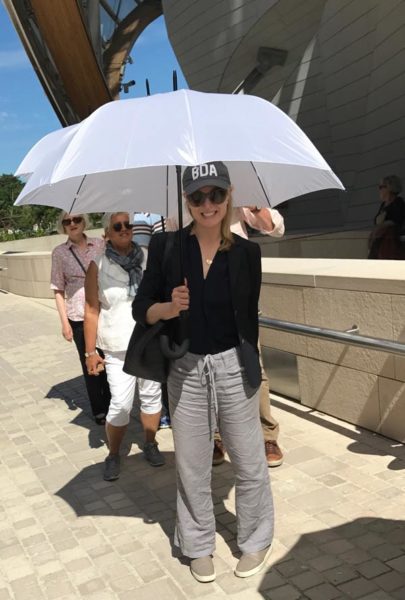Photo: TIM MACPHERSON/GETTY IMAGES
One of the best sun protection strategies is to go where the sun is not. It’s free and easy if you keep it in mind, so put shade on your radar!
Have you ever looked closely at someone who has been careful about sun exposure since birth? If so, you were likely mesmerized by the smooth, clear, ageless quality of that person’s skin. I was, when I recently sat next to a woman at a fundraiser whose arms were like flawless porcelain. Her face was unwrinkled and unspotted, despite her busy life as a mom and physician. She told me it was thanks to a lifetime of vigilance, instilled by her mother. That included the whole arsenal of sun defense weapons, including the one that probably is talked about the least: shade.
If you think wrinkles, sagging, dark spots, leathery texture and uneven skin tone are just natural signs of aging, you’re fooling yourself. An estimated 90 percent of skin aging is caused by the sun. That holds true for people of any skin tone, not just those with vary light skin.
You probably already know that the sun’s ultraviolet (UV) radiation is the cause of most skin cancers. Every little exposure, even on a cool or cloudy day, can start to damage the DNA in your skin cells. Your body repairs some of it, but not all, and the damage accumulates over your lifetime. Of course, a sunburn is damage. Tanning is also damage. Even one adorable little freckle is damage. Shade can help.
“Yes to shade, 100 percent,” says New York City dermatologist Elizabeth K. Hale, MD, who has pretty fabulous skin herself. As a Mohs surgeon and specialist in the diagnosis and treatment of skin cancer, Dr. Hale says she talks to her patients all the time about sun protection. “They tell me they wear sunscreen,” she says, “but I can see that many of them are still ‘laying out’ and seeking a tan. Just wearing sunscreen isn’t a free pass to lie in the sun in the middle of the day when UV rays are strongest. That is a whole disconnect.”
Of course, we all want to have fun and spend time outside, but if you can do your activities earlier or later in the day, that is a smart step. (And when shadows are long, there is more shade.) If you are outside during peak sun hours, sunscreen, while vital, is just one part of the picture. Clothing, hats and sunglasses are important, too. And whenever shade is an option, take it. “I think shade is undervalued and probably as important as all the other things we recommend for sun protection,” says Dr. Hale, who is a senior vice president of The Skin Cancer Foundation.
Find Existing Shade
Whenever you’re outside, train yourself to take advantage of whatever shade you can find. Park on the shady side of the store or mall, so you can be more protected as you walk from the car to the entrance. If you’re in a park, pick a shady bench or picnic spot under leafy trees. If you’re waiting for someone, say you’ll “be over there in the shade.” If you’re walking in a city, cross over to the shady side of the street.
“Studies have shown that most sun damage we get throughout our life is what we call incidental sun exposure,” Dr. Hale explains. It’s not just the times you’re on vacation or at the beach or pool; it’s the day-in, day-out exposure. “Little steps like crossing the street to walk on the shady side add up and make a difference in protecting your skin.”
Follow the Shade
 Have you noticed, when you’re sitting under a stationary beach or pool umbrella, that your shade patch seems to move? Remember, the earth rotates fast, changing your angle to the sun every few minutes, and suddenly your face or feet are poking out of the shade. Be aware and adjust your chair (or position or umbrella angle) as needed to stay in the shade while you’re out.
Have you noticed, when you’re sitting under a stationary beach or pool umbrella, that your shade patch seems to move? Remember, the earth rotates fast, changing your angle to the sun every few minutes, and suddenly your face or feet are poking out of the shade. Be aware and adjust your chair (or position or umbrella angle) as needed to stay in the shade while you’re out.
Make Your Own Shade
Sun exposure at athletic events is a hazard for many people. Dr. Hale and her sister, Julie K. Karen, MD (also a dermatologist and partner with Dr. Hale at CompleteSkinMD in New York City) spend a lot of time outdoors watching their kids’ games. “I put on sunscreen and wear a hat, but it can still feel unpleasant to have the sun beating down on you while you’re at a game. And you can be out there for hours,” Dr. Hale says.
The Skin Cancer Foundation recommends wide-brimmed hats to help shade your head and face. “But the overwhelming majority of my patients, and those at spectator games, are wearing baseball caps,” says Dr. Hale. “Those are better than nothing, but I see a lot of skin cancer as well as a lot of sun damage on the lateral cheeks, the jawline and ears. Even people who have good intentions and do apply sunscreen and then wear a baseball hat are getting sun damage on the side of the face.” They may not be applying sunscreen all the way back to the ears and back of the neck or reapplying every two hours. Dr. Hale says that undesirable hyperpigmentation is common on the sides of the face, and she has also seen dangerous melanomas there. Shade can help. If you see empty seats in a shaded part of the bleachers, consider moving. Dr. Hale says she frequently does that.

Practicing What She Preaches! Whether in Paris (above) or rooting for a kid’s soccer win closer to home, Dr. Hale keeps it shady. Photo: Courtesy of Elizabeth K. Hale, MD
There are a lot of soccer moms who watch their kids play all the time, says Dr. Hale, and for them, sun exposure is a serious issue. “I have found personal, portable shade, like a sun-protective umbrella, to be very helpful. It is effective and makes sitting outside much more comfortable.”
Personal sun umbrellas, or parasols, have protected skin throughout history. Dr. Hale, Dr. Karen and their kids use them. “When it’s hot outside, the breeze gets in and it feels cooler. There’s less glare in your eyes.” If you’re buying a sun umbrella, Dr. Hale says to look for one with ultraviolet protection factor (UPF) of 50+. A dark, tightly woven or reflective umbrella fabric usually offers better protection than a light, translucent one.
Shade isn’t perfect, as UV rays can reflect and bounce off of other surfaces, but Dr. Hale recommends protective umbrellas at the pool and beach, as long as you use other sun protection, too. Remember, UPF hats and clothing are shade for your head and body, and UV-blocking sunglasses are shade for your eyes and the surrounding area.
Request Shade
While protecting your skin from sun is just as important in cool or cold weather as it is when it’s hot out, heat can make clothing and hats less comfortable to wear. Shade can help! When Dr. Hale was in Africa with her family in 2019, the heat was scorching. “It was about 108 degrees,” she recalls. “When we were in the safari vehicles without canopies, wearing our floppy hats and sunscreen, it was hot and uncomfortable for us and our kids. After that, we requested the vehicles with a canopy. It felt cooler and was more protective.”
When it comes to shade in other countries, Dr. Hale says, “I think it’s worth pointing out how mandated it is in Australia, considered the skin cancer capital of the world. Kids have to wear broad-brimmed hats to school, and they have a strict ‘no hat, no play’ policy for recess. Playgrounds are required to have shade built over them, too.” They’re ahead of the U.S. when it comes to protecting their kids. Concerned parents everywhere can advocate for more shade — and many schools and communities have raised money or solicited volunteers to make it happen.
Be Shady!
It’s clear that putting shade on your radar can pay off by helping to prevent skin cancer, Dr. Hale says. But remember that those rays that contribute to skin cancer also age the skin, break down collagen and cause sun spots, every day and every time you’re outside. “People should keep that in mind,” she says: While walking in direct sunlight sometimes may feel good, it’s not. It’s healthier to be in the shade.”
She says she’s noticed that “with my kids, it is such a common phrase right now to say of someone’s behavior: ‘That’s so shady!’ What if we could turn that around to be something more positive, like, ‘It’s good to be shady,’ or ‘It’s OK to be shady.’ Or better yet, ‘It’s cool to be shady.’ Maybe we can make it a meme!”
The bottom line is, when it comes to any healthy habit, small efforts are cumulative and add up over time. If you put Dr. Hale’s advice into daily practice, your beautiful skin will have it made — in the shade.






